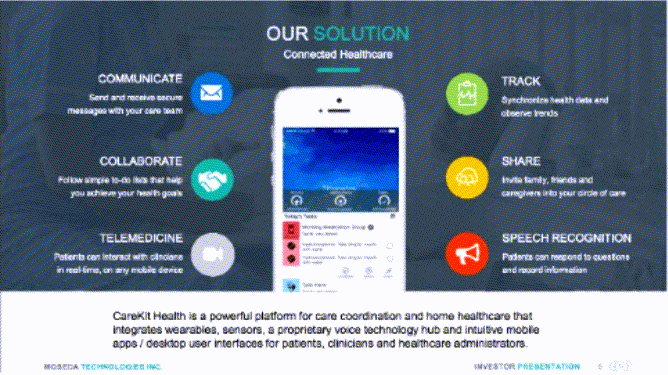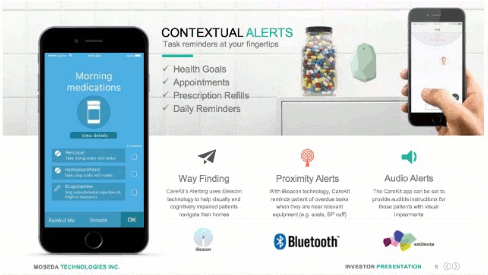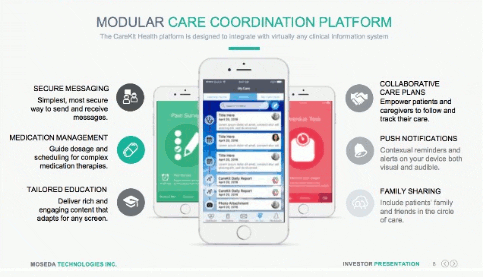When it comes to the importance of technology and the innovation it offers, perhaps no market is more significant than the community care and personal health space. All too often, the ability of individuals to receive the care they need is hindered by matters of mobility – a situation that can make a big, big difference in terms of quality and length of life.
Offering solutions to such questions is what Vancouver-based startup Reliq Health Technologies (RHT.C) is all about.
The company started life as a mobile security company, transitioned into fleet management telematics, and ultimately found its feet in the area of telemedicine, where Reliq’s iUGO Health technology platform combines hardware and software and the cloud to offer high-quality care assistance at home.
But first: What is Telemedicine?
At its heart, Reliq is developing secure and innovative mobile solutions for a community care market that, currently, sits at about $20 billion in value, and is growing rapidly as medical professionals realize the importance of ongoing care, rather than just during the hour of a visit in a doctor’s office.
It’s a huge opportunity both to compete and to offer progressive change in how people are cared for — something Dr. Lisa Crossley, CEO of Relig Health Technologies, discussed with me last week.
“Our solution,” Crossley explains, “integrates wearables, sensors and voice technology to create a fully automated ‘virtual hospital room’ in the patient’s home, providing real-time tracking of patients’ vital signs, medication adherence and movements within the home.”
If that sounds like the medical equivalent of a lojack, that’s kind of the point, Crossley explained.
With a patient’s vital information remotely available to doctors and uploaded to the cloud, the Reliq clinical care team can keep an eye on everything from instability in a patient’s vital signs to whether or not that patient is taking their medication as prescribed.
Falls in the home, meanwhile — a major issue when there’s no doctor present and the fallen may have difficulty reaching the phone — would also be mitigated by the total health awareness the system provides.
And that’s just the start. The list of benefits, Crossley says, goes on, and can be added to over time.
“[The iUGO Health Technology platform] allows for early interventions by the care team before a health crisis occurs,” Crossley said, “Preventing costly and disruptive hospital re-admissions and ER visits.”
For patients, interactive voice technology transmits audible alerts, reminding them to record and collect their vitals, take medication or perform exercises, and also allows patients access to their health information — the same information available to doctors on the other end — simply through voice interaction. This information, Crossley said, includes “patient education materials, care team contact information, a summary of previously-collected patient health data and a current schedule of home visits, virtual consults, doctor’s appointments and other upcoming interventions.”
The Reliq Health system, though, isn’t only intended to be a high-tech, innovative way for care specialists simply to watch over their charges. It also allows patients the means to care for themselves with more resources and information at their disposal, Crossley says.
“Reliq Health empowers patients to actively participate in managing their own health at home. Our platform was designed specifically for chronically ill and elderly patients, as well as homecare providers and family members who may not be particularly tech-savvy. Reliq also boasts a robust https://e4njohordzs.exactdn.com/wp-content/uploads/2021/10/tnw8sVO3j-2.pngistrative dashboard for clinicians and healthcare https://e4njohordzs.exactdn.com/wp-content/uploads/2021/10/tnw8sVO3j-2.pngistrators to facilitate patient population and care team resource management.”
Ultimately, what seems to work best with the model is how it works to mitigate problems that make modern health care unsustainable, something that makes the delivery of health care difficult and even ineffective in many cases, Reliq argues.
Chronic conditions — accounting for three-fourths of total global healthcare costs — are often poorly managed by patients at home, leading to frequent re-admissions. Those re-admissions can be costly for https://e4njohordzs.exactdn.com/wp-content/uploads/2021/10/tnw8sVO3j-2.pngistrators, who face Medicare chargebacks on patients that are readmitted too soon.
In making its case to investors, Crossley points to a quickly changing health care sector in the US that used to send patients away and hope they don’t come back, but now sees profitability in ensuring proper delivery of treatment in the months after a surgery. Telemedicine is a big deal. The question for Reliq will be, whether or not they can penetrate that health system and be fully recognized as a better option.
So far, so good. While investors have taken their time to understand and get behind the new push (the stock has had several moments of momentum over the last six months, only to be dragged down on profit-taking), the company has laid out some interesting pilot projects with large American health groups that point to not just a much-needed tech, but also the ability of the CEO to make use of her network from previous companies.
Crossley has a solid track record in the business, with good exits and several substantial startups in her past, all in this sector. Indeed, if you were going to select a telemedicine CEO, there aren’t that many people to choose from that are immersed in that field. Crossley is one of them.
As for what’s to come, the CEO says she’s in monetization mode.
“We’ve done the work on the technology. It works. What we’re doing now is showing those companies that know they need something like this to stay ahead, or have no clue they need it but will soon.”
— Todd Aalgaard.



